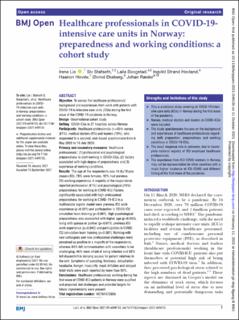| dc.description.abstract | Abstract Objective To survey the healthcare professionals’ background and experiences from work with patients with COVID-19 in intensive care units (ICUs) during the first wave of the COVID-19 pandemic in Norway. Design Observational cohort study. Setting COVID-ICUs in 27 hospitals across Norway. Participants Healthcare professionals (n=484): nurses (81%), medical doctors (9%) and leaders (10%), who responded to a secured, web-based questionnaire from 6 May 2020 to 15 July 2020. Primary and secondary measures Healthcare professionals’: (1) professional and psychological preparedness to start working in COVID-ICUs, (2) factors associated with high degree of preparedness and (3) experience of working conditions. Results The age of the respondents was 44.8±10 year (mean±SD), 78% were females, 92% had previous ICU working experience. A majority of the respondents reported professional (81%) and psychological (74%) preparedness for working in COVID-ICU. Factors significantly associated with high professional preparedness for working in COVID-19-ICU in a multivariate logistic model were previous ICU work experience (p<0.001) and participation in COVID-ICU simulation team training (p<0.001). High psychological preparedness was associated with higher age (p=0.003), living with spouse or partner (p=0.013), previous ICU work experience (p=0.042) and participation in COVID-ICU simulation team training (p=0.001). Working with new colleagues and new professional challenges were perceived as positive in a majority of the respondents, whereas 84% felt communication with coworkers to be challenging, 46% were afraid of being infected and 82% felt discomfort in denying access for patient relatives to the unit. Symptoms of sweating, tiredness, dehydration, headache, hunger, insecurity, mask irritation and delayed toilet visits were each reported by more than 50%. Conclusions Healthcare professionals working during the first wave of COVID-ICU patients in Norway were qualified and prepared, but challenges and potential targets for future improvements were present. | en_US |

